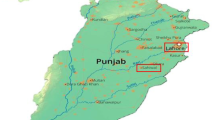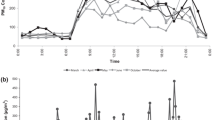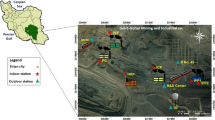Abstract
The renovation of a building will certainly affect the quality of air in the vicinity of where associated activities were undertaken, this includes the quality of air inside the building. Indoor air pollutants such as particulate matter, heavy metals, and fine fibers are likely to be emitted during renovation work. This study was conducted to determine the concentration of heavy metals, asbestos and suspended particulates in the Biology Building, at the Universiti Kebangsaan, Malaysia (UKM). Renovation activities were carried out widely in the laboratories which were located in this building. A low-volume sampler was used to collect suspended particulate matter of a diameter size less than 10 μm (PM10) and an air sampling pump, fitted with a cellulose ester membrane filter, were used for asbestos sampling. Dust was collected using a small brush and scope. The concentration of heavy metals was determined through the use of inductively coupled plasma–mass spectroscopy and the fibers were counted through a phase contrast microscope. The concentrations of PM10 recorded in the building during renovation action (ranging from 166 to 542 μg m − 3) were higher than the value set by the Department of Safety and Health for respirable dust (150 μg m − 3). Additionally, they were higher than the value of PM10 recorded in indoor environments from other studies. The composition of heavy metals in PM10 and indoor dust were found to be dominated by Zn and results also showed that the concentration of heavy metals in indoor dust and PM10 in this study was higher than levels recorded in other similar studies. The asbestos concentration was 0.0038 ± 0.0011 fibers/cc. This was lower than the value set by the Malaysian Department of Occupational, Safety and Health (DOSH) regulations of 0.1 fibers/cc, but higher than the background value usually recorded in indoor environments. This study strongly suggests that renovation issues need to be considered seriously by relevant stakeholders within the university in order to ensure that the associated risks toward humans and indoor environment are eliminated, or where this is not feasible, minimized as far as possible.
Similar content being viewed by others
References
Ã-zkaynak, H., Xue, J., Spengler, J., Wallace, L., Pellizzari, E., & Jenkins, P. (1996). Personal exposure to airborne particles and metals: Results from the particle team study in Riverside, California. Journal of Exposure Analysis and Environmental Epidemiology, 6, 57–78.
Al-Rajhi, M. A., Seaward, M. R. D., & Al-Aamer, A. S. (1996). Metal levels in indoor and outdoor dust in Riyadh, Saudi Arabia. Environment International, 22, 315–324. doi:10.1016/0160-4120(96)00017-7.
Bernstein, J. A., Alexis, N., Bacchus, H., Bernstein, I. L., Fritz, P., Horner, E., et al. (2008). The health effects of nonindustrial indoor air pollution. Journal of Allergy and Clinical Immunology, 121, 585–591. doi:10.1016/j.jaci.2007.10.045.
Bogovski, S., Lang, I., Rjazanov, V., Muzyka, V., Tuulik, V., & Vitak, A. (2007). Assessment of potential hazards during the process of house building in Estonia. International Journal of Environmental Health Research, 17, 105–112. doi:10.1080/09603120701219238.
Braniš, M., Řezàčovà, P., & Domasovà, M. (2005). The effect of outdoor air and indoor human activity on mass concentrations of PM10, PM2.5, and PM1 in a classroom. Environmental Research, 99, 143–149. doi:10.1016/j.envres.2004.12.001.
Brown, S. K. (1987). Asbestos exposure during renovation and demolition of asbestos–cement clad buildings. American Industrial Hygiene Association Journal, 48, 478–486. doi:10.1080/15298668791385075.
Brunekreef, B., & Holgate, S. T. (2002). Air pollution and health. Lancet, 360, 1233–1242. doi:10.1016/S0140-6736(02)11274-8.
Chao, C. Y., & Wong, K. K. (2002). Residential indoor PM10 and PM2.5 in Hong Kong and the elemental composition. Atmospheric Environment, 36, 265–277. doi:10.1016/S1352-2310(01)00411-3.
Chattopadhyay, G., Lin, K. C. P., & Feitz, A. J. (2003). Household dust metal levels in the Sydney metropolitan area. Environmental Research, 93, 301–307. doi:10.1016/S0013-9351(03)00058-6.
Corn, M., Crump, K., Farrar, D. B., Lee, R. J., & McFee, D. R. (1991). Airborne concentrations of asbestos in 71 school buildings. Regulatory Toxicology and Pharmacology, 13, 99–114. doi:10.1016/0273-2300(91)90044-V.
Deng, Q. H., Shi, B. B., Li, J. D., & Lu, C. (2009). Chemical composition and source apportionment of particulate matter (PM10) in university classrooms. Zhongnan Daxue Xuebao (Ziran Kexue Ban)/Journal of Central South University (Science and Technology,) 40, 322–328.
Draper, M. H., & Dufus, J. H. (1997). General overwiew of scientific presentation. In: J. H. Dufus (Ed.), Carcinogenicity of inorganic substances (pp. 6–18). Cambridge: The Royal Society of Chemistry.
Dufault, R., Abelquist, E., Crooks, S., Demers, D., DiBerardinis, L., Franklin, T., et al. (2000). Reducing environmental risk associated with laboratory decommissioning and property transfer. Environmental Health Perspectives, 108, 1015–1022.
Edimansyah, B. A., Rusli, B. N., Naing, L., Azwan, B. A., & Aziah, B. D. (2009). Indoor air quality in an automotive assembly plant in Selangor, Malaysia. Southeast Asian Journal of Tropical Medicine and Public Health, 40, 187–192.
Ekmekcioglu, D., & Keskin, S. S. (2007). Characterization of indoor air particulate matter in selected elementary schools in Istanbul, Turkey. Indoor and Built Environment, 16, 169–176. doi:10.1177/1420326X07076777.
El-Hougeiri, N., & El Fadel, M. (2004). Correlation of indoor–outdoor air quality in urban areas. Indoor and Built Environment, 13, 421–431. doi:10.1177/1420326X04049344.
Farfel, M. R., Orlova, A. O., Lees, P. S. J., Rohde, C., Ashley, P. J., & Chisolm, J. J. Jr. (2003). A study of urban housing demolitions as sources of lead in ambient dust: demolition practices and exterior dust fall. Environmental Health Perspectives, 111, 1228–1234.
Gemenetzis, P., Moussas, P., Arditsoglou, A., & Samara, C. (2006). Mass concentration and elemental composition of indoor PM2.5 and PM10 in University rooms in Thessaloniki, northern Greece. Atmospheric Environment, 40, 3195–3206. doi:10.1016/j.atmosenv.2006.01.049.
Godish, T. (2000). Indoor environmental quality. Florida: CRC.
Grassian, V. H. (2009). New directions: nanodust—a source of metals in the atmospheric environment? Atmospheric Environment, 43, 4666–4667. doi:10.1016/j.atmosenv.2009.06.032.
Hameed, A. A. A., Yasser, I. H., & Khoder, I. M. (2004). Indoor air quality during renovation actions: a case study. Journal of Environmental Monitoring, 6, 740–744. doi:10.1039/b402995j.
Hasegawa, A., Schleibinger, H., Nong, G., & Lusztyk, E. (2009). Effects of renovation work on air quality and occupants health in university buildings. Clean-Soil, Air, Water, 37, 475–480. doi:10.1002/clen.200800215.
Janssen, N. A. H., Hoek, G., Harssema, H., & Brunekreef, B. (1997). Childhood exposure to PM10: Relation between personal, classroom, and outdoor concentrations. Occupational and Environmental Medicine, 54, 888–894.
Janssen, N. A. H., Hoek, G., Brunekreef, B., & Harssema, H. (1999). Mass concentration and elemental composition of PM10 in classrooms. Occupational and Environmental Medicine, 56, 482–487.
Jones, A. P. (1999). Indoor air quality and health. Atmospheric Environment, 33, 4535–4564. doi:10.1016/S1352-2310(99)00272-1.
Kakkar, P., & Jaffery, F. N. (2005). Biological markers for metal toxicity. Environmental Toxicology and Pharmacology, 19, 335–349. doi:10.1016/j.etap.2004.09.003.
Kangur, M. (2007). Occupational exposure to asbestos during renovation of oil-shale fuelled power plants in Estonia. International journal of occupational safety and ergonomics: JOSE, 13, 341–346.
KildesÃ, J., Vallarino, J., Spengler, J. D., Brightman, H. S., & Schneider, T. (1999). Dust build-up on surfaces in the indoor environment. Atmospheric Environment, 33, 699–707. doi:10.1016/S1352-2310(98)00258-1.
Klinmalee, A., Srimongkol, K., & Kim Oanh, N. T. (2009). Indoor air pollution levels in public buildings in Thailand and exposure assessment. Environmental Monitoring and Assessment, 156, 581–594. doi:10.1007/s10661-008-0507-z.
Kuehn, T. H. (1996). Construction/renovation influence on indoor air quality. ASHRAE Journal, 38.
Latif, M. T., Othman, M. R., Kim, C. L., Murayadi, S. A., & Sahaimi, K. N. A. (2009). Composition of household dust in semi-urban areas in Malaysia. Indoor and Built Environment, 18, 155–161. doi:10.1177/1420326X09103014.
Lawson, J. A., Dosman, J. A., Rennie, D. C., Beach, J., Newman, S., & Senthilselvan, A. (2009). Relationship between indoor environment and asthma and wheeze severity among rural children and adolescents. Journal of Agromedicine, 14, 277–285. doi:10.1080/10599240902772910.
Layton, D. W., & Beamer, P. I. (2009). Migration of contaminated soil and airborne particulates to indoor dust. Environmental Science and Technology, 43, 8199–8205. doi:10.1021/es9003735.
Lee, R. J., & Van Orden, D. R. (2008). Airborne asbestos in buildings. Regulatory Toxicology and Pharmacology, 50, 218–225. doi:10.1016/j.yrtph.2007.10.005.
Lee, S. C., Guo, H., Li, W. M., & Chan, L. Y. (2002). Inter-comparison of air pollutant concentrations in different indoor environments in Hong Kong. Atmospheric Environment, 36, 1929–1940. doi:10.1016/S1352-2310(02)00176-0.
Lee, R. J., Strohmeier, B. R., Bunker, K. L., & Van Orden, D. R. (2008). Naturally occurring asbestos—A recurring public policy challenge. Journal of Hazardous Materials, 153, 1–21. doi:10.1016/j.jhazmat.2007.11.079.
Lioy, P. J., Freeman, N. C. G., Wainman, T., Stern, A. H., Boesch, R., Howell, T., et al. (1992). Microenvironmental analysis of residential exposure to chromium-laden wastes in and around New Jersey homes. Risk Analysis, 12, 287–299. doi:10.1111/j.1539-6924.1992.tb00676.x.
Lippmann, M. (1990). Man-made mineral fibers (MMMF): Human exposures and health risk assessment. Toxicology and Industrial Health, 6, 225–246.
Lyons, T. J., & Reynolds, M. H. (1996). Exposure to hazardous materials during renovation for existing structures. ASTM Special Technical Publication, 1258, 401–417.
Oliver, L. C., & Shackleton, B. W. (1998). The indoor air we breathe. Public Health Reports, 113, 398–409.
Pastuszka, J. S. (2009). Emission of airborne fibers from mechanically impacted asbestos–cement sheets and concentration of fibrous aerosol in the home environment in Upper Silesia, Poland. Journal of Hazardous Materials, 162, 1171–1177. doi:10.1016/j.jhazmat.2008.06.045.
Pastuszka, J. S. (2010). Emission of airborne fibers from mechanically impacted non-asbestos fiber-containing materials preliminary results. Archives of Environmental Protection, 36(2), 3–12.
Ping, C. Z. (2008) Concentration of PM10 in Biology Building, Universiti Kebangsaan Malaysia. BSc. Thesis. Universiti Kebangsaan Malaysia
Rasmussen, P. E., Subramanian, K. S., & Jessiman, B. J. (2001). A multi-element profile of house dust in relation to exterior dust and soils in the city of Ottawa, Canada. Science of the Total Environment, 267, 125–140. doi:10.1016/S0048-9697(00)00775-0.
Reynolds, S. J., Kreiger, R. A., Bohn, J. A., Fish, D., Marxhausen, T., & McJilton, C. (1994). Factors affecting airborne concentrations of asbestos in a commercial building. American Industrial Hygiene Association Journal, 55, 823–828.
Sakai, K., NorbaÌ^ck, D., Mi, Y., Shibata, E., Kamijima, M., Yamada, T., et al. (2004). A comparison of indoor air pollutants in Japan and Sweden: formaldehyde, nitrogen dioxide, and chlorinated volatile organic compounds. Environmental Research, 94, 75–85. doi:10.1016/S0013-9351(03)00140-3.
Sauni, R., Oksa, P., Vattulainen, K., Uitti, J., Palmroos, P., & Roto, P. (2001). The effects of asthma on the quality of life and employment of construction workers. Occupational Medicine, 51, 163–167. doi:10.1093/occmed/51.3.163.
Sen, D., Wolfson, H. & Dilworth, M. (2002). Lead exposure in scaffolders during refurbishment construction activity—an observational study. Occupational Medicine, 52, 49–54. doi:10.1093/occmed/52.1.49.
Sohn, M. D., Apte, M. G., Sextro, R. G., & Lai, A. C. K. (2007). Predicting size-resolved particle behavior in multizone buildings. Atmospheric Environment, 41, 1473–1482. doi:10.1016/j.atmosenv.2006.10.010.
Sohn, J., Yang, W., Kim, J., Son, B., & Park, J. (2009). Erratum to “Indoor air quality investigation according to age of the school buildings in Korea” [J. Environ. Manage. 90 (2008) 348–354]. Journal of Environmental Management, 90, 1962–1962. doi:10.1016/j.jenvman.2008.12.003.
Tahir, N. M., Chee, P. S., & Jaafar, M. (2007). Determination of heavy metals content in soils and indoor dusts from nurseries in Dungun, Terengganu. Malaysian Journal of Analytical Sciences, 11, 280–286.
Tong, S. T. Y. & Lam, K. C. (1998). Are nursery schools and kindergartens safe for our kids? The Hong Kong study. Science of The Total Environment, 216, 217–225. doi:10.1016/S0048-9697(98)00161-2.
Turner, W. A. (1998). Controlling ventilation during renovation. HPAC Heating, Piping, Air Conditioning, 70, 49–52.
Vijayanand, C., Rajaguru, P., Kalaiselvi, K., Selvam, K. P., & Palanivel, M. (2008). Assessment of heavy metal contents in the ambient air of the Coimbatore city, Tamilnadu, India. Journal of Hazardous Materials, 160, 548–553. doi:10.1016/j.jhazmat.2008.03.071.
Wang, X., Bi, X., Sheng, G., & Fu, J. (2006). Hospital indoor PM10/PM2.5 and associated trace elements in Guangzhou, China. Science of the Total Environment, 366, 124–135. doi:0.1016/j.scitotenv.2005.09.004.
Yang, W., Sohn, J., Kim, J., Son, B., & Park, J. (2009). Indoor air quality investigation according to age of the school buildings in Korea. Journal of Environmental Management, 90, 348–354. doi:10.1016/j.jenvman.2007.10.003.
Yiin, L. M., Lu, S. E., Sannoh, S., Lim, B. S., & Rhoads, G. G. (2004). Evaluation of cleaning methods applied in home environments after renovation and remodeling activities. Environmental Research, 96, 156–162. doi:10.1016/j.envres.2004.01.007.
Young, J. M., Kelly, T. M., & Vance, L. (2008). Determination of size fractions and concentrations of airborne particulate matter generated from construction and demolition waste processing facilities. Air Quality Atmosphere and Health, 1, 91–100. doi:10.1007/s11869-008-0015-x.
Author information
Authors and Affiliations
Corresponding author
Rights and permissions
About this article
Cite this article
Latif, M.T., Baharudin, N.H., Velayutham, P. et al. Composition of heavy metals and airborne fibers in the indoor environment of a building during renovation. Environ Monit Assess 181, 479–489 (2011). https://doi.org/10.1007/s10661-010-1843-3
Received:
Accepted:
Published:
Issue Date:
DOI: https://doi.org/10.1007/s10661-010-1843-3




